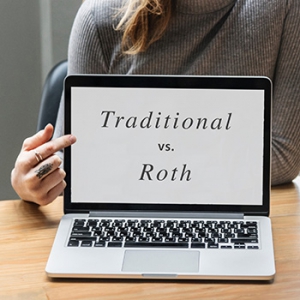 Woo-hoo! Happy April 15th! It’s Federal Income Tax Filing Deadline Day! No? Not a cause for celebration at your house? Ok, then – we’ll move on to something useful then: Traditional IRAs vs. Roth IRAs.
Woo-hoo! Happy April 15th! It’s Federal Income Tax Filing Deadline Day! No? Not a cause for celebration at your house? Ok, then – we’ll move on to something useful then: Traditional IRAs vs. Roth IRAs.
Each year I repeatedly hear the question “Which is better: a Roth or a Traditional IRA?” And each year, I hear people giving nonsense answers… it drives me nuts. A rule of thumb — If you ask a financial professional which you should go with, and the first question out of her/his mouth is: “How old are you?” you should remove your shoe (hopefully it is heavy boot day) and throw it at said advisor’s head. This advice also works for online dating as well, should you find yourself in that arena at any point in the future. (Don’t actually throw your shoe. It’s a metaphor. But I think you see what I mean.)
Starting our analysis
Let’s start with a little math, and I will try not to be too nerdy. Assume that over a five-year period your investment returns were +5% in the first year, +12% in the second year, -8% in the third, +26% in the fourth and a -2% in the fifth year. If you started with $100, your investment return over that period would be equal to $100 x 1.05 x 1.12 x 0.92 x 1.26 x 0.98 = $133.60. Then, let’s say your tax rate today is 20%.
 What happens with a Traditional IRA
What happens with a Traditional IRA
If you took that $100 and put it into a Traditional IRA, you would not pay taxes on that money today. Furthermore, you would not owe taxes on the money until you withdraw it in retirement. So let’s assume you do exactly that – you put $100 into a traditional IRA, get the returns we listed over five years, and withdraw your $133.60 in retirement. At that point, we will once again assume your tax rate is 20%. You will withdraw your $133.60, pay 20% ($26.72) to the Federal Government in taxes, and have $106.88 to fund your riotous lifestyle; perhaps you can supersize the fries!
What happens with a Roth IRA
If, however, we took our $100 from our gross paycheck and paid 20% in taxes upfront, that would leave us $80 to invest. It then goes into our Roth IRA, in which it will grow tax free. If we go back to our five years of returns and multiply $80 x 1.05 x 1.12 x 0.92 x 1.26 x 0.98, we get what? Answer: $106.88.
The key deciding factor between Traditional and Roth IRAs
Well, the results are the same. Exactly the same. The key is to focus on our assumption about tax rates. See our example in which the tax rate when we made the original investment was 20%, and the tax rate at the time of withdrawal was also 20%. This is critical to note, and here’s why.
In the real world, tax rates are very likely to be different at the time you make the original investment and when it is withdrawn. This is the key factor in deciding whether to open a Roth or a Traditional IRA.
So, will your tax rate on regular income be higher or lower in retirement? An argument for a lower tax rate in retirement is that you have a salary today and are likely to have a lower taxable income in retirement. This would likely put you into lower tax brackets in retirement. The arguments for a higher tax rate in retirement is our expanding federal debt load, our increased budgets every year and thirst for more and more social welfare programs.
 Which should you choose?
Which should you choose?
So, when choosing between Traditional or Roth IRAs (or 401(k)s) my advice to you hearkens back to a basic investing principle: Diversification. Not only should we think about diversifying among and within asset classes, but also in the tax treatment of our various accounts. Most of us should have some tax-deferred, some tax-free, and some taxable investment accounts — a financial advisor can help you with this.
Grandma was right about not keeping those eggs in one basket, and you don’t want to argue with your grandmother, do you?
April 2019
Disclosure
Content in this material is for general information only and not intended to provide specific advice or recommendations for any individual. This is a hypothetical example and is not representative of any specific situation. Your results will vary. The hypothetical rates of return used do not reflect the deduction of fees and charges inherent to investing. Investing involves risk including loss of principal.
The Roth IRA offers tax deferral on any earnings in the account. Withdrawals from the account may be tax free, as long as they are considered qualified. Limitations and restrictions may apply. Withdrawals prior to age 59 ½ or prior to the account being opened for 5 years, whichever is later, may result in a 10% IRS penalty tax. Future tax laws can change at any time and may impact the benefits of Roth IRAs. Their tax treatment may change.
Contributions to a traditional IRA may be tax deductible in the contribution year, with current income tax due at withdrawal. Withdrawals prior to age 59 ½ may result in a 10% IRS penalty tax in addition to current income tax.




